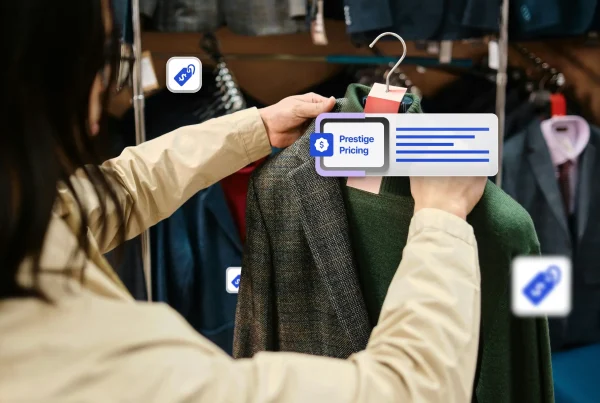Every buyer has asked this, even if they didn’t say it out loud, “Is it worth it?” As pricing professionals, your job isn’t to answer that question. It is to shape how it’s asked in the first place. That’s where price anchoring comes into play. It’s not just another psychological pricing tactic; it’s a strategic lever used to reframe the value conversation before it even begins.
But here’s the problem. Most companies use price anchoring as a gimmick. A flashy crossed-out number next to a discount. A “premium” product is placed to make the standard one seem like a deal. The anchoring effect is real, but using it carelessly can backfire—or worse, go unnoticed by the customer entirely.
What if we looked deeper? What if price anchoring wasn’t about smoke and mirrors, but a precise method to guide the decision-making process, intentionally, and with measurable impact?
This blog will unpack what price anchoring is, how it works, when it matters, and what others aren’t telling you. If you think you’ve already mastered this pricing strategy, keep reading. You might be anchoring, but are you anchoring well?
What Is Price Anchoring?
Price anchoring is a psychological pricing strategy that uses a reference price—called the anchor price—to influence how a customer evaluates the value of a product or service.
The concept is simple, but powerful. When presented with a high initial price, customers unconsciously compare every other option against it. This comparison shifts their perception of value, what’s fair, and what’s a deal.
This isn’t just theory. Price anchoring is a psychological phenomenon rooted in behavioral economics. Known as the anchoring effect, it explains how people rely heavily on the first piece of information they see when making decisions. That first number becomes the mental benchmark, even if it’s arbitrary.
Examples of Price Anchoring Effect
- A SaaS company lists its $499/month “Enterprise” plan first, followed by a $199 “Professional” plan. That $199 feels more reasonable—even cheap—because the high price has been set.
- A retailer shows the original price of a jacket as $180, with a discounted price of $119. That “was” price isn’t just a strikethrough; it reframes the entire value perception.
- A pricing page displays three options—Basic, Plus, and Premium. The Premium plan exists mainly as a decoy. Its job? Make the middle plan seem more attractive by comparison. That’s anchoring, combined with the decoy effect.
Anchoring is especially effective because pricing is rarely absolute. Customers don’t walk into a store or land on a pricing page with an objective sense of what your product or service should cost. Instead, they rely on cues. Anchors give them those cues, intentionally or not.
But here’s the catch: not all anchors work. Some lead to better conversions. Others simply confuse customers. Understanding when and how to use price anchoring is what separates gimmicks from strategy.
Why Is Price Anchoring Important?
In pricing, perception often matters as much as reality. You can build clean margin models, run cost-plus pricing, or benchmark meticulously. But if the customer doesn’t feel they’re getting a fair deal, you lose. Price anchoring is what lets you shape that feeling—intentionally and effectively.
Anchoring is not a gimmick. It’s a psychological pricing tool that fills a gap in customer knowledge. Most buyers don’t arrive with a clear idea of what your product or service should cost. Anchoring sets a reference point so they’re not guessing—or worse, comparing you to the wrong thing.
Here’s why anchoring is critical to modern pricing strategy:
- It reframes price sensitivity. When you introduce a higher anchor first, you shift the entire scale of what feels acceptable. Even if customers don’t choose the highest price, their reference point moves, making your target price seem more attractive.
- It supports win-win pricing strategies. Anchoring helps you lead buyers to mid-tier or value-rich offerings. These price points often offer a better deal with the best balance of margin and volume, and anchoring helps steer buyers there without resistance.
- It protects value in a discount-heavy environment. Many companies default to discounts as the path to conversion. Anchoring does the opposite. It drives value perception without eroding pricing power or brand positioning.
- It neutralizes competitor anchoring. If you’re not setting the anchor, your competitors are. And their pricing—especially if it’s artificially low—can distort customer expectations. Strategic price anchoring gives you back control of the conversation.
- It improves perceived fairness. Surprisingly, a higher original price followed by a lower actual price feels fairer to many customers. The contrast builds the sense of savings, if executed with credibility.
- It enhances tiered pricing. When you offer three or more options, the anchoring effect strengthens. A higher-priced plan or product, placed first, can make others look more reasonable, even if the features haven’t changed.
- It influences internal confidence. Anchoring isn’t just for customers. It helps align sales and marketing teams by defining the value ladder clearly. When everyone understands the role of each price point, sales conversations become more consistent and persuasive.
- It shapes long-term brand positioning. High-quality brands use anchoring not just to close sales, but to send a message: “This is what premium looks like.” Even if customers buy the mid-tier offer, they’ve seen the ceiling—and that ceiling redefines the floor.
Anchoring is powerful because it taps into how people naturally make decisions. They compare. They seek value. And they rarely assess price in isolation. Anchoring gives you the ability to guide that comparison, not through pressure, but through structure.
How to Implement Price Anchoring?
Implementing a price anchor isn’t as simple as showing a higher price and hoping the customer bites. That’s where most strategies fall apart. Anchoring is a pricing strategy that works only when the context, timing, and psychological cues align. It needs to be clear, credible, and calculated—because your buyers aren’t just looking at numbers. They’re interpreting value.
Here’s how to implement price anchoring effectively and consistently across digital and offline channels.
1. Start With the Right Anchor Price
The anchor should be credible, not arbitrary. If it feels inflated, it damages trust. Use either:
- A higher-tier product or service that you offer.
- The original price before the discount.
- A comparable option from competitor pricing.
- A premium plan designed specifically to act as a decoy, priced high with just enough added value to seem legitimate.
Your goal is not to deceive, but to guide. Anchoring is a psychological tool, and price anchoring is a psychological cue, not a false promise.
2. Use Price Anchoring Across the Full Price Display
Anchoring works best when it’s visible and reinforced. That means showing price anchors clearly on your pricing page, in proposals, and even in sales presentations. Format and layout matter.
- Show the higher price first.
- Use strikethroughs only when the original price is still believable.
- Highlight the perceived gain, not just the lower price.
For example, “Originally $1,200 — now $849” does more than show savings. It implies that the value has been retained.
3. Price Tiers to Create a Win-Win for You and the Shopper
Here is an example with three tiers where the middle tier delivers the most value to the shopper and drives the most financial benefit to you:
- The entry plan is priced low with clear limitations.
- The middle plan, rich in features and value, while driving good margins for you
- The high-end plan, priced much higher, often has a marginal benefit.
The higher price acts as the anchor, making the middle option seem more reasonable. This is anchoring plus tiering—one of the most effective pricing strategies in SaaS, services, and digital products.
4. Customize Anchors Based on Segments (Advanced)
This is where most companies fall short. One-size-fits-all anchors don’t perform equally across customer types.
- Enterprise buyers need anchors that signal scale and long-term ROI.
- SMBs respond better to anchors that contrast complexity with simplicity.
- Repeat customers already have mental anchors. You must adjust around those.
With modern tools and data, it’s now possible to implement dynamic anchoring strategies. Based on buyer behavior, industry, or prior engagement, your system can present tailored anchor prices at scale.
Very few organizations are doing this well. It’s a frontier opportunity.
5. Anchor Early—But Not Too Early
Anchoring is part of the decision-making process, but timing matters. If you drop the anchor before the value is clear, customers will reject it. If you delay it too long, they’ll anchor to external comparisons.
Anchoring isn’t just about numbers—it’s about contextual framing.
6. Monitor Performance and Adjust
Anchoring isn’t “set it and forget it.” Consumer psychology shifts. Competitor pricing evolves. And what worked six months ago might underperform today.
Track metrics like:
- Conversion rate by price tier
- Engagement with pricing page elements
- Customer feedback on perceived value
Test different anchor placements, pricing tiers, and decoy strategies. Anchoring can lead to improved revenue, but only if it evolves with your market.
Anchoring is easy to execute poorly. When done well, it drives pricing power, increases perceived value, and supports broader pricing strategies without racing to the bottom.
Also Read: Surge Pricing Explained: Risks, Strategy, and How to Get It Right
Does Price Anchoring Work?
Yes—but only when used with intent. In retail, price anchoring is everywhere. From the original price on a markdown tag to tiered pricing on a display, anchor prices shape how shoppers judge value. The anchoring effect works by setting a mental benchmark. It changes what seems expensive and what feels like a deal.
Anchoring can lead to higher conversions, better sell-through, and improved perceived value, without changing the product or service. It helps shift focus from absolute cost to relative value. That’s the real power of psychological pricing.
But anchoring fails when it’s overused or poorly timed. If the anchor price feels fake, customers ignore it. In high-transparency categories like groceries, shoppers rely on competitor pricing or past knowledge. Repeat buyers may not respond at all. Anchoring is most effective when it’s credible, consistent, and tailored to the product and customer.
When to Use Psychological Pricing Tactic with Price Anchoring Strategy
Not every pricing scenario benefits from anchoring. Used in the wrong context, it adds noise. Used well, it shifts perception, drives value realization, and strengthens your pricing position. The key is timing and fit.
Here’s when to lean into a price anchoring strategy:
1. When the Value Isn’t Immediately Obvious
If your product or service is complex, customizable, or premium, anchoring helps frame the offer. Without an anchor, the buyer may default to lower expectations or lean too heavily on competitor pricing. Anchoring lets you control the first impression.
2. When You Offer Multiple Pricing Tiers
This is the classic scenario where the price anchoring strategy shines. A higher-priced plan makes the mid-tier option seem more attractive. The buyer sees value through comparison, not in isolation.
3. When Entering a New Market or Launching a New Product
When customers have no prior reference point, they’ll look for cues. Anchoring gives them one. A high anchor can establish a premium position early, even if the actual offer is competitively priced.
4. When Discounting Strategically
Anchoring is key to showing the difference between the original price and the discounted price. Without that anchor, the perceived savings are weak, even if the deal is strong.
5. When Facing a Pricing War
Anchoring helps shift the conversation from price to value. While competitors may slash prices, you reframe what “expensive” means. Anchoring can protect both margins and brand position.
When to Avoid Anchoring
There are times when it can do more harm than good:
- If your product is low-margin and low-consideration, anchoring can overcomplicate the decision.
- If customers are highly familiar with the price point (e.g., gas, groceries), anchoring has limited impact.
- If your anchor isn’t credible, it can erode trust.
Anchoring is most powerful when used deliberately, not by default. It’s a strategy, not a formatting choice.
Final Thoughts
The first number a customer sees shouldn’t be random. It should be deliberate. Anchoring isn’t about manipulating perception—it’s about earning trust through structure. It helps people make sense of pricing, especially when the product, the context, or the stakes are unfamiliar. And in a market full of noise, the ability to guide that judgment—quietly and confidently—is a competitive edge.
But strategy only works when it’s executed well, at scale, and without guesswork. That’s where AI-native Impact Analytics PriceSmart™ helps—by turning pricing decisions into systems that perform, adapt, and win.
Frequently Asked Questions
Is price anchoring manipulative or unethical?
When done with transparency and credibility, price anchoring helps customers make informed decisions by providing context, not deception. It guides perception, not misleads it.
Can I use price anchoring without offering discounts?
Anchoring doesn’t require markdowns. It can be built using premium tiers, competitive comparisons, or value-rich decoy options, without reducing your price.
How do I know if my anchor price is working?
Track metrics like conversion rates by tier, time spent on pricing pages, and customer feedback. If your middle-tier plan consistently performs best, your anchor is likely effective.





